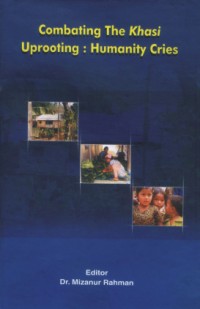Combating the khasi uprooting: humanity cries
Sultan
Mahmud Ripon
'Combating
the Khasi Uprooting: Humanity Cries' is published by Empowerment through
Law of the Common People (ELCOP) and edited by Professor Dr. Mizanur
Rahman.
Contact Address: 333/1, Shegun Bagicha (2nd Floor), Dhaka, Bangladesh.
 'Combating
the Khasi Uprooting: Humanity Cries' is a collective research effort
undertaken by a group of anti-generic law students of the three leading
public universities in the country: the Dhaka University, the Rajshahi
University and the Chittagong University. These student-researchers
shared a deep sense of commitment towards protection of rights of the
minorities of the country. They have for the first time tried to analyse
the deprivation and alienation of the Khasis from a politico-economical
perspective. A}thors have tried to find answers to issues like why the
Khasis are Khasis, what makes them indigenous, how have they been divorced
from traditional land rights, what makes them feel aliens on their own
land? etc.etc.
'Combating
the Khasi Uprooting: Humanity Cries' is a collective research effort
undertaken by a group of anti-generic law students of the three leading
public universities in the country: the Dhaka University, the Rajshahi
University and the Chittagong University. These student-researchers
shared a deep sense of commitment towards protection of rights of the
minorities of the country. They have for the first time tried to analyse
the deprivation and alienation of the Khasis from a politico-economical
perspective. A}thors have tried to find answers to issues like why the
Khasis are Khasis, what makes them indigenous, how have they been divorced
from traditional land rights, what makes them feel aliens on their own
land? etc.etc.
It contains 8 chapters
including the introduction and the conclusion. The introductory chapter
is followed in Chapter 2 by an ethno-sociological profile of the Khasi.
The chapter trace{ the historical origin of the Khasi and discusses
why this community should be treated as an indigenous community entitled
to various specific rights and safeguards. Geographical mapping of the
Khasi, especially identification of the main centres of their concentration
substantially enriches this chapter.
Disintegration,
subordination and marginalization of the Khasi community comprise the
central theme of chapter 3. In this chapter the political history of
the region inhabited by the Khasi is measured alongside their gradual
loss of power and economic independence. The authors provided sufficient
evidence and arguments to conclude that 'numeric inadequacy, strong
sense of ethnic identity, monopoly domination, disempowerment and violence'
are the main causes for marginalization of the Khasi people.
Ho the various
factors accounting for disintegration and dispersion of the Khasi community
are at work in the everyday life of the community is depicted in the
next chapter on the 'present socio-economic structure of the Khasi community'.
The analysis however, goes far beyond mere narration of the socio-economic
life of the community and touches upon delicate political life of the
community including various aspects of traditional communal governance.
This chapter also reminds us about the growing disparity between the
theory and practice of constitutional rights and freedoms enjoyed (?)
by the Khasi as citizens of Bangladesh.
The above theme
is further elaborated on the basis of field experience in chapter 5
dealing with 'Political subordination of the Khasi community'. It shows
how |raditional i.e. more common means of exerting pzessure are put
alongside 'innovative' means to compel the Khasi to remain subservient
to dominant economic and political interests and ideology.
Chapter 6 concentrates
basically on the social life of the Khasi community and illustratms
how changes in the economic and political structure of the community
have changed the inner life of the community members, including its
relioious belief.
The succeeding chapter
is mssentially the logical conclusion of the whole research. If the
Khasi continue to live the life they are compelled to live today, if
all the factors remain in thmir respective places playing their respective
d}e roles, and if the state i.e. the Peoples' Republic of Bangladesh
does not intervene to protect the 'indigenousness' of the community
and promote its rights and freedoms, what impact would it have on the
Khasi? The title of chapter 7 is an unfortunate reminder of what lies
ahead: dissolution of the ethnic and subordination of the Khasi to dominant
culture.
This however, is
commensurate neither with the Proclamation of Independence of the Peoples'
Republic of Bangladesh nor with the constitutional rights and guarantees.
Therefore, in the concluding chapter the authors make recommendations
for positive actions to be taken primarily by the government of Bangladesh.
These recommendations speak for a comprehensive programme of action
to protect the Khasi as an indigenous community. It is not mere protection
of their economic interests, but protection of their socio-political
life, ideology, way of life etc. A human rights response cannot be otherwise.